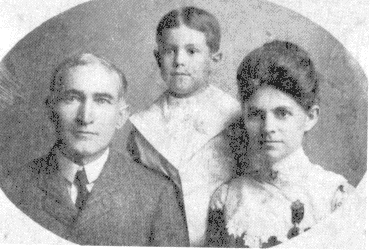Schools in Craig County
First County Superintendent
-by Gladks (Franklin) Martin

First County School Superintendent
Harvey Shelton, wife Mae (Duncan) Shelton
and their son Harvey, Jr.
Today’s modern educational systems are a far cry from those first public schools that came into existence in Craig County with statehood in 1907-a date when the county’s first school superintendent began his difficult duties in the new state.
County superintendents were selected and Craig County chose a 43-year old Democrat and part-Cherokee experienced educator. His name was Harvey Wirt Courtland SHELTON, son of a Texas Confederate brigadier general of the Civil War. Hundreds of rural and small-town public schools came after statehood, replacing the many Indian schools and neighborhood subscription schools. Some of the larger towns and cities had public schools, established after passage of the Curtis Bill in 1898, which provided for collecting taxes to support schools.
Smaller towns and settlements were, for the most part, forgotten areas. White children could attend Indian schools by payment of tuition. Craig County was typical of the counties in Indian Territory. In one month after statehood, approval had been given for the establishment of 60 schools in Craig County, and by 1910 there were 62 regular schools and nine separate schools in the county.
Shelton served through two terms as county Superintendent-the turbulent period of organizing and instructing school boards in their duties, advising in the location of schools, helping in the employment of teachers and giving examinations, looking after summer normal work and carrying out the multitude of duties assigned to his office.
He was to receive from $3 per day to $1,000 per annum. He and other first county superintendents earned every cent of their warrants. Problems were many and varied. Most of the school district board members were interested in promoting education but many were uneducated themselves.
Teachers were paid from $35 to $60 a month, and a job was easier to obtain by those who attended the summer normal or institute held in the area.
Teachers were frequent targets of complaints by patrons and school board members alike. One teacher denied the charge that he had hugged one of the girls or used profane language as claimed by a Maybelle district patron, and counter-charged that the party was “trying to break up the school.”
From a West Cabin School district patron came a letter wanting to know “if our teacher has the right to have debating and literary societies and such like during school hours.” The writer added that outsiders were attending the events-young men and ladies-“more for courtship than anything else.”
A Welch district school board member wrote complaining about the “lack of mature judgment of our 17-year old teacher” and asking for another one a-bit older.
A Centralia teacher confessed to the charge that he had given an unruly boy six licks with a piece of an old buggy whip. “There are no switches here,” he added, and also reported he was resigning because pupils were staying out of school, apparently in protest.
A Bluejacket school report told of the employment of a janitor at their school for 10 cents per school day. One board member wanted to know if the teacher could compel children to sweep the schoolhouse after school. The official felt it was the job of the teacher to sweep out.
There were fights over location of the school that often became bitter just as there were disagreements over the hiring of the teacher, the election of board members, the naming of the school and the length of the school term.
Although the law required children from 6 to 16 to attend at least three months of school a year, difficulties were common in enforcing the compulsory attendance law. Lawsuits were frequent in solving this problem as well as other school matters. Epidemics of disease struck at intervals forcing the schools to close as outbreaks were not uncommon. A letter from A.W.
HERRON, M.D., Craig County Superintendent of Health, warned teachers and officers in 1909 to disinfect school rooms regularly at least once a week, and in times of epidemic, more often.
A county superintendent was forced to “wear many hats” and at times he was the judge and jury; at others mediator, counselor, referee, accountant and advisor. School building and operation were new to most people so they looked to him for guidance.
It was this type of dedication on the part of the early county school superintendent and district school boards, unfamiliar as these directors were with their duties, that helped launch Oklahoma’s school system on its way upward.